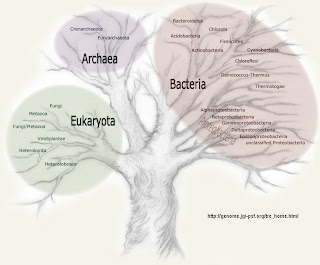This is a complex between parts of the T-cell receptor (green and blue) and the major histocompatibility complex class II molecule (MHC class II) shown in orange and yellow. There's a peptide bound in the presentation site of the class molecule (red).
When a cell becomes infected with a virus, various viral proteins are broken down into peptides and bound to a site on class II molecules. These molecules are then presented on the surface of the cell when they can be recognized by the T-cell receptor. Since the viral peptide will be seen as a foreign antigen, the infected cell will be destroyed.
The Nobel Laureates are Rolf Zinkernagel and Peter Doherty.
There weren't very many correct answers this week1 but Markus-Frederik Bohn thought it was very easy. He's a graduate student at the Lehrstuhl für Biotechnik in Erlangen, Germany. He has a Canadian connection but I'll let him reveal it in the comments if he wishes.
 This is a very famous molecular complex. You need to identify this complex by naming all the major components. You will not win if you skip this part. (Don't forget the red bit.)
This is a very famous molecular complex. You need to identify this complex by naming all the major components. You will not win if you skip this part. (Don't forget the red bit.)There is a Nobel Prize associated with the discover of this complex although the work was done long before the structure was solved. The first person to identify the molecules and the Nobel Laureate(s), wins a free lunch. Previous winners are ineligible for six weeks from the time they first won the prize.
There are only five ineligible candidates for this week's reward: Dima Klenchin of the University of Wisconsin at Madison, Dara Gilbert of the University of Waterloo, Anne Johnson of Ryerson University, Cody Cobb, soon to be a graduate student at Rutgers University in New Jersey, and Alex Ling of the University of Toronto.
I have an extra free lunch for a deserving undergraduate so I'm going to continue to award an additional prize to the first undergraduate student who can accept it. Please indicate in your email message whether you are an undergraduate and whether you can make it for lunch.
THEME:
Nobel Laureates
Send your guess to Sandwalk (sandwalk (at) bioinfo.med.utoronto.ca) and I'll pick the first email message that correctly identifies the molecule(s) and names the Nobel Laureate(s). Note that I'm not going to repeat Nobel Prizes so you might want to check the list of previous Sandwalk postings by clicking on the link in the theme box.
Correct responses will be posted tomorrow.
Comments will be blocked for 24 hours.
1. Because immunology isn't biochemistry and possibly not even a real science.
The figure is from Reinherz et al. (1999).
Reinherz, E.L., Tan, K., Tang, L., Kern, P., Liu, J., Xiong, Y., Hussey, R.E., Smolyar, A., Hare, B., Zhang, R., Joachimiak, A., Chang, H.C., Wagner, G., and Wang, J. (1999) Science 286:1913-1921. [PubMed] [doi: 10.1126/science.286.5446.1913]














